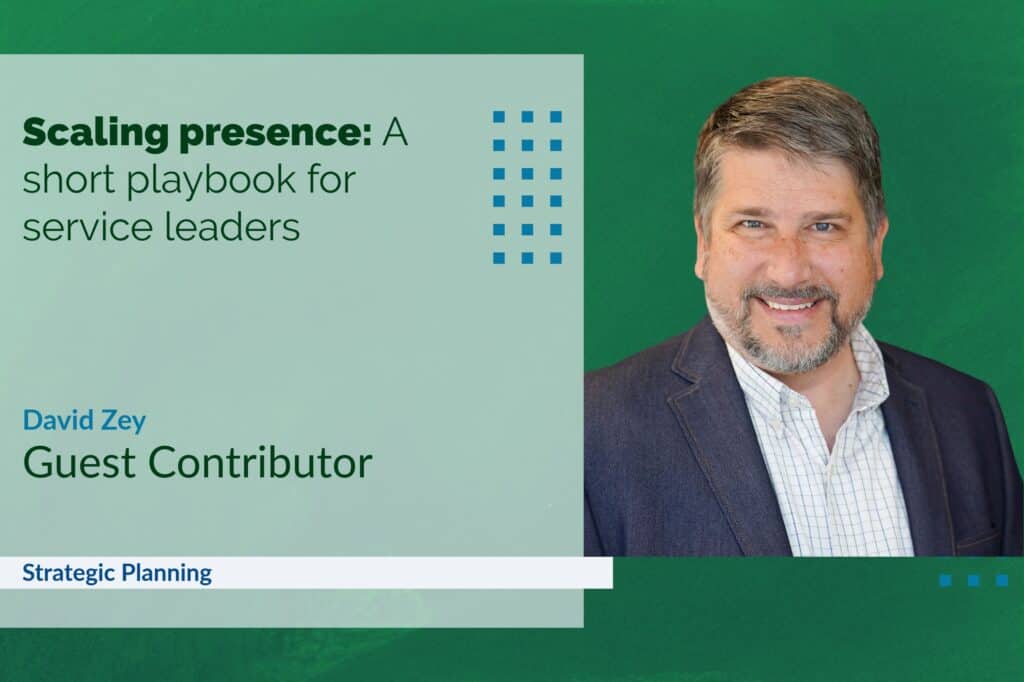
October 20, 2025
Last issue’s column explored the paradox of scaling service: the more customers you serve, the harder it becomes to stay present.
This follow-up is for leaders who want to keep their businesses human as they grow.
The goal is simple: give customer-facing team members more time and better context, while ensuring backstage complexity exists only to make the frontstage simple, clear and personal.
Play 1: Map the moments of presence
Why: Presence is built or lost in a few repeatable interactions.
How: List your top five customer touchpoints (first response, status update, scope change, invoice or renewal, post-issue follow-up).
For each, tag it:
- Human-only: Don’t automate; protect the conversation
- Augment: Draft with AI, finish by a human
- Automate: Send automatically, but leave a clear escape hatch for a person
Watch out for: Automating “human-only” moments like delivering bad news or discussing pricing changes.
Measure: Track response consistency and add a one-line “felt cared for” pulse after each key moment.
Play 2: Build a single source of promise (SSoP)
Why: Frontstage presence collapses when what was sold isn’t what can be delivered.
How: In one shared place visible to sales, delivery and support, capture what was promised, including the scope, constraints, service levels, pricing assumptions and “what we will not do.”
Watch out for: Private notes that never reach the people talking to customers.
Measure: Promise-kept rate – the percentage of interactions where reality matches what was promised, not just the service level agreement.
Play 3: Free 20% for human presence
Why: Presence needs time.
Create it on purpose.
How: Identify two or three repetitive backstage tasks starving your frontstage (status pings, scheduling, confirmations).
Automate those first.
Set a presence time target.
For example, 20-30% of frontline hours are reserved for proactive outreach, clarifying calls and follow-ups.
Watch out for: Automation that increases ticket volume with templated replies but no resolution.
Measure: Actual presence time versus target, plus quality notes from proactive human touches.
Play 4: Write through-line briefs for backstage systems
Why: Backend complexity is only justified if it simplifies the customer’s experience.
How: For each system or process, write a one-sentence brief:
- “We do [a complex thing] because [operational reason] so that the customer gets [simple, reliable outcome].”
- Example: “We segment SKUs and auto-route exceptions because it reduces rework so that customers always get a clear, accurate delivery date.”
Watch out for: Any process you can’t explain in that “because/so-that” sentence should be redesigned or cut.
Measure: Whether the promised simple outcome is consistently felt at the mapped moments of presence.
Play 5: Preserve the ‘deliberately messy’ zones
Why: Some messy moments build trust.
Don’t iron them flat.
How: Mark engagement points where conversation beats automation, such as price changes, scope trade-offs and service recovery.
Require a human voice, with AI only preparing context, options and company SOP reminders.
Watch out for: Process automation that removes negotiation, apology or teaching moments.
Measure: Recovery satisfaction after exceptions and the percentage of exceptions handled through a real conversation.
Guardrails for AI that amplify presence
AI can strengthen presence but only when it’s designed to serve people, not replace them.
The best systems follow a few clear guardrails:
- Route high-impact or high-emotion moments to humans, fast. When a customer is frustrated, when the dollar value of an issue is significant or when context is unclear, the technology’s job is to flag and escalate and not to respond on its own.
- Never let automation become a dead end. Every message or notification generated by a system should make it obvious how to reach a real person. When customers feel trapped in a loop of automated replies, trust erodes faster than any efficiency gain can offset.
- Choose transparency over polish. It’s better to show what’s fixed and what’s flexible (e.g., time, cost or scope) than to hide behind perfectly worded but ambiguous statements. Honest clarity builds dialogue, reduces the “surprise tax” that shows up later and gives customers the feedback that makes you more competitive over time.
When AI follows these principles, it stops being a wall between company and customer and becomes what it should be: a bridge that gives people more time and better information to be present when it matters most.
The few metrics that keep you honest
- Promise-kept rate: Frontstage reality versus what was sold
- Presence time: Percent of frontline hours in proactive, human contact
- First-truth rate: Percent of interactions where trade-offs were stated up front
- Human-touch ratio: Are your “human-only” moments still human?
- Employee load index: If people are underwater, presence won’t scale
A 30-day starter plan
- Map your top five moments of presence and tag them (human-only/augment/automate)
- Stand up a lightweight SSoP and make it visible to sales, delivery and support
- Automate one repetitive backstage task; reinvest that time into proactive outreach
- Add a “first-truth” line to quotes or renewals: What changes cost or time fastest?
- Review one complex backstage process, write its through-line brief and cut anything you can’t justify
Presence doesn’t scale by accident.
It scales through the decisions leaders make about how people spend their time, where they focus their attention and what they protect from automation.
Every process, tool and policy either amplifies or erodes that presence.
When systems are designed with care, technology becomes a silent ally and creates space for the conversations, clarity and trust that define lasting relationships.
In the end, customers remember more than what you delivered.
They remember how you showed up while delivering it.
Scaling presence isn’t about growing bigger – it’s about growing closer, even as you expand.
 Sunshine to offset most of Dramm’s Algoma facility’s energy needs
Sunshine to offset most of Dramm’s Algoma facility’s energy needs  From one ‘green thumb’ to another, The Plant People under new ownership
From one ‘green thumb’ to another, The Plant People under new ownership







